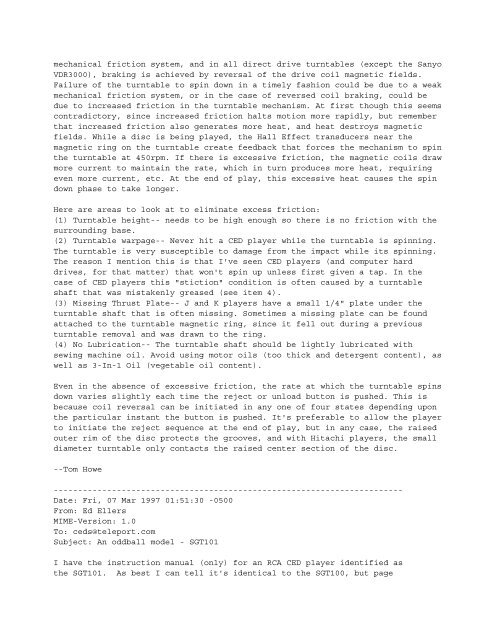You also want an ePaper? Increase the reach of your titles
YUMPU automatically turns print PDFs into web optimized ePapers that Google loves.
mechanical friction system, and in all direct drive turntables (except the Sanyo<br />
VDR3000), braking is achieved by reversal of the drive coil magnetic fields.<br />
Failure of the turntable to spin down in a timely fashion could be due to a weak<br />
mechanical friction system, or in the case of reversed coil braking, could be<br />
due to increased friction in the turntable mechanism. At first though this seems<br />
contradictory, since increased friction halts motion more rapidly, but remember<br />
that increased friction also generates more heat, and heat destroys magnetic<br />
fields. While a disc is being played, the Hall Effect transducers near the<br />
magnetic ring on the turntable create feedback that forces the mechanism to spin<br />
the turntable at 450rpm. If there is excessive friction, the magnetic coils draw<br />
more current to maintain the rate, which in turn produces more heat, requiring<br />
even more current, etc. At the end of play, this excessive heat causes the spin<br />
down phase to take longer.<br />
Here are areas to look at to eliminate excess friction:<br />
(1) Turntable height-- needs to be high enough so there is no friction with the<br />
surrounding base.<br />
(2) Turntable warpage-- Never hit a <strong>CED</strong> player while the turntable is spinning.<br />
The turntable is very susceptible to damage from the impact while its spinning.<br />
The reason I mention this is that I've seen <strong>CED</strong> players (and computer hard<br />
drives, for that matter) that won't spin up unless first given a tap. In the<br />
case of <strong>CED</strong> players this "stiction" condition is often caused by a turntable<br />
shaft that was mistakenly greased (see item 4).<br />
(3) Missing Thrust Plate-- J and K players have a small 1/4" plate under the<br />
turntable shaft that is often missing. Sometimes a missing plate can be found<br />
attached to the turntable magnetic ring, since it fell out during a previous<br />
turntable removal and was drawn to the ring.<br />
(4) No Lubrication-- The turntable shaft should be lightly lubricated with<br />
sewing machine oil. Avoid using motor oils (too thick and detergent content), as<br />
well as 3-In-1 Oil (vegetable oil content).<br />
Even in the absence of excessive friction, the rate at which the turntable spins<br />
down varies slightly each time the reject or unload button is pushed. This is<br />
because coil reversal can be initiated in any one of four states depending upon<br />
the particular instant the button is pushed. It's preferable to allow the player<br />
to initiate the reject sequence at the end of play, but in any case, the raised<br />
outer rim of the disc protects the grooves, and with Hitachi players, the small<br />
diameter turntable only contacts the raised center section of the disc.<br />
--Tom Howe<br />
------------------------------------------------------------------------<br />
Date: Fri, 07 Mar 1997 01:51:30 -0500<br />
<strong>From</strong>: Ed Ellers<br />
MIME-Version: 1.0<br />
To: ceds@teleport.com<br />
Subject: An oddball model - SGT101<br />
I have the instruction manual (only) for an RCA <strong>CED</strong> player identified as<br />
the SGT101. As best I can tell it's identical to the SGT100, but page


